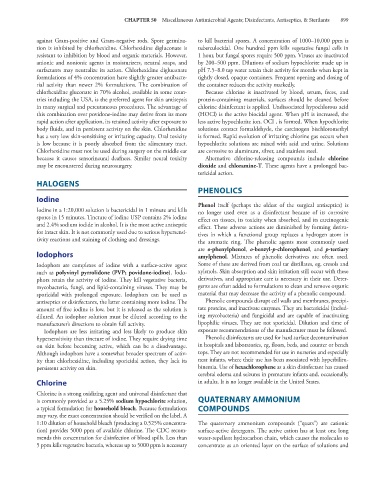Page 913 - Basic _ Clinical Pharmacology ( PDFDrive )
P. 913
CHAPTER 50 Miscellaneous Antimicrobial Agents; Disinfectants, Antiseptics, & Sterilants 899
against Gram-positive and Gram-negative rods. Spore germina- to kill bacterial spores. A concentration of 1000–10,000 ppm is
tion is inhibited by chlorhexidine. Chlorhexidine digluconate is tuberculocidal. One hundred ppm kills vegetative fungal cells in
resistant to inhibition by blood and organic materials. However, 1 hour, but fungal spores require 500 ppm. Viruses are inactivated
anionic and nonionic agents in moisturizers, neutral soaps, and by 200–500 ppm. Dilutions of sodium hypochlorite made up in
surfactants may neutralize its action. Chlorhexidine digluconate pH 7.5–8.0 tap water retain their activity for months when kept in
formulations of 4% concentration have slightly greater antibacte- tightly closed, opaque containers. Frequent opening and closing of
rial activity than newer 2% formulations. The combination of the container reduces the activity markedly.
chlorhexidine gluconate in 70% alcohol, available in some coun- Because chlorine is inactivated by blood, serum, feces, and
tries including the USA, is the preferred agent for skin antisepsis protein-containing materials, surfaces should be cleaned before
in many surgical and percutaneous procedures. The advantage of chlorine disinfectant is applied. Undissociated hypochlorous acid
this combination over povidone-iodine may derive from its more (HOCl) is the active biocidal agent. When pH is increased, the
–
rapid action after application, its retained activity after exposure to less active hypochlorite ion, OCl , is formed. When hypochlorite
body fluids, and its persistent activity on the skin. Chlorhexidine solutions contact formaldehyde, the carcinogen bischloromethyl
has a very low skin-sensitizing or irritating capacity. Oral toxicity is formed. Rapid evolution of irritating chlorine gas occurs when
is low because it is poorly absorbed from the alimentary tract. hypochlorite solutions are mixed with acid and urine. Solutions
Chlorhexidine must not be used during surgery on the middle ear are corrosive to aluminum, silver, and stainless steel.
because it causes sensorineural deafness. Similar neural toxicity Alternative chlorine-releasing compounds include chlorine
may be encountered during neurosurgery. dioxide and chloramine-T. These agents have a prolonged bac-
tericidal action.
HALOGENS
PHENOLICS
Iodine
Iodine in a 1:20,000 solution is bactericidal in 1 minute and kills Phenol itself (perhaps the oldest of the surgical antiseptics) is
no longer used even as a disinfectant because of its corrosive
spores in 15 minutes. Tincture of iodine USP contains 2% iodine effect on tissues, its toxicity when absorbed, and its carcinogenic
and 2.4% sodium iodide in alcohol. It is the most active antiseptic effect. These adverse actions are diminished by forming deriva-
for intact skin. It is not commonly used due to serious hypersensi- tives in which a functional group replaces a hydrogen atom in
tivity reactions and staining of clothing and dressings. the aromatic ring. The phenolic agents most commonly used
are o-phenylphenol, o-benzyl-p-chlorophenol, and p-tertiary
Iodophors amylphenol. Mixtures of phenolic derivatives are often used.
Iodophors are complexes of iodine with a surface-active agent Some of these are derived from coal tar distillates, eg, cresols and
such as polyvinyl pyrrolidone (PVP; povidone-iodine). Iodo- xylenols. Skin absorption and skin irritation still occur with these
phors retain the activity of iodine. They kill vegetative bacteria, derivatives, and appropriate care is necessary in their use. Deter-
mycobacteria, fungi, and lipid-containing viruses. They may be gents are often added to formulations to clean and remove organic
sporicidal with prolonged exposure. Iodophors can be used as material that may decrease the activity of a phenolic compound.
antiseptics or disinfectants, the latter containing more iodine. The Phenolic compounds disrupt cell walls and membranes, precipi-
amount of free iodine is low, but it is released as the solution is tate proteins, and inactivate enzymes. They are bactericidal (includ-
diluted. An iodophor solution must be diluted according to the ing mycobacteria) and fungicidal and are capable of inactivating
manufacturer’s directions to obtain full activity. lipophilic viruses. They are not sporicidal. Dilution and time of
Iodophors are less irritating and less likely to produce skin exposure recommendations of the manufacturer must be followed.
hypersensitivity than tincture of iodine. They require drying time Phenolic disinfectants are used for hard surface decontamination
on skin before becoming active, which can be a disadvantage. in hospitals and laboratories, eg, floors, beds, and counter or bench
Although iodophors have a somewhat broader spectrum of activ- tops. They are not recommended for use in nurseries and especially
ity than chlorhexidine, including sporicidal action, they lack its near infants, where their use has been associated with hyperbiliru-
persistent activity on skin. binemia. Use of hexachlorophene as a skin disinfectant has caused
cerebral edema and seizures in premature infants and, occasionally,
Chlorine in adults. It is no longer available in the United States.
Chlorine is a strong oxidizing agent and universal disinfectant that
is commonly provided as a 5.25% sodium hypochlorite solution, QUATERNARY AMMONIUM
a typical formulation for household bleach. Because formulations COMPOUNDS
may vary, the exact concentration should be verified on the label. A
1:10 dilution of household bleach (producing a 0.525% concentra- The quaternary ammonium compounds (“quats”) are cationic
tion) provides 5000 ppm of available chlorine. The CDC recom- surface-active detergents. The active cation has at least one long
mends this concentration for disinfection of blood spills. Less than water-repellent hydrocarbon chain, which causes the molecules to
5 ppm kills vegetative bacteria, whereas up to 5000 ppm is necessary concentrate as an oriented layer on the surface of solutions and

